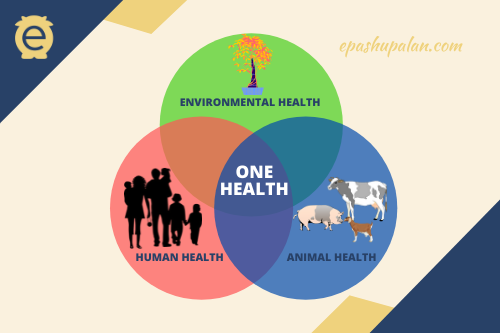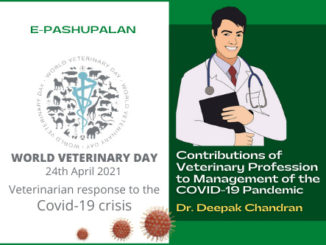All veterinary graduates entering into the profession take oath of not only protection of animal health and welfare but also prevention and relief of animal suffering, the conservation of animal resources, promotion of public health and advancement of medical knowledge. The oath reflects society’s expectations of a veterinarian. Each component holds relevance to the one health concept through attention to human health, domestic animal health, and to a lesser extent ecosystem health. Veterinary science is a multifaceted subject which is concerned with the treatment of vast range of species including companion, farm and wild animals. They are also involved in wide range of activities associated with the disease diagnosis, prevention and control of disease, performing surgeries besides addressing the problem of zoonotic diseases which are of public health concern. They also have a key role in vetero-legal cases, where they are required to speak with authority and pragmatism as animals advocate. Thus in a nut shell they are bestowed with the noble responsibility of ensuring the animals their much deserved right of five freedoms i.e. freedom from hunger, freedom from discomfort (i.e. having shelter), freedom from pain and suffering (disease), freedom to express its normal behavior, freedom from fear and distress.

Owing to the fact that more than half of the human diseases are of animal origin, all the activities of animal science affects the human health either directly or indirectly. The veterinary research transcends species boundaries and has the responsibilities of handling not only the animal diseases but also has to provide a more comprehensive solution for human health through addressing the problems of human diseases of animals origin, food safety and wildlife and ecosystem health. In these causes the veterinarian is a partner with zoologists and conservationists for treatment and relief of animals at the time of forest fire or other natural disasters which not only affects wild species but companion and domestic animals also. He is an important member of the community health team with medicos for diagnosis and prevention of zoonotic diseases and through their role in public services by ensuring stringent inspection at all stages of production and distribution of food of animal origin.
One Health concept
There was a worldwide panic in the first decade of this century associated with several pandemics like Severe Acute Respiratory Disease (SARS), Avian Inflenza and Swine flu and other diseases of zoonotic importance. These pandemics drew attention towards the interconnection between the human and the source of these infections in their animal reservoirs and hence the genesis of the concept of ‘one health’ for global control of such diseases was materialized. Though ‘one health’ is a new phrase and the current concept can be thought of to be only 7-8 years old, but the origin of the concept can be traced back to the time of Aristotle (500 B.C.) and Hippocrates (340 B.C.). Aristotle wrote ‘Historia Animalium’ to elaborate the natural zoonotic history of animals. Greek physician Hippocrates also provided insight into effect of environmental factors on human health in his text ‘On Airs, Waters and Places’. In 1761 Claude Bourghelat while laying the foundation of first veterinary school at Lyon, France emphasized upon the importance of comparative biopathology. The origin of the essence of modern ‘One Health’ initiative can be attributed to this concept of comparative medicine. Later in mid 1800’s, Rudolf Virchow proposed that ‘between animal and human medicine there is no dividing line- nor there should be. The object is different but the experience obtained constitutes the basis of all medicine.’ Since then with the advent of time, the theme has been rebranded several times.

The current definition of one health comes from the word ‘one medicine’ coined by Calvin Schwabe, which is a shorter form of ‘one health’ and longer representation of ‘one world, one health and one medicine’. This is an exciting movement to encourage wildlife, domestic animal and human health professionals to work collectively to address the world’s most challenging health concerns. In twenty first century, many individuals and organizations have set up their own definition of one health, but the common thread is collaborative efforts on a global scale among multiple disciplines to attain optimal health for the people, animals and the ecosystem (including wildlife).
Role of Veterinarian in one health- historical perspective and present scenario
The first Veterinary school was established at Lyon, France in 1761 to combat Rinderpest, the most dreaded disease of cattle at that time. Subsequently many Veterinary Institutes were established in Europe and other parts of the world. In nineteenth and early part of the twentieth century veterinary training was focused on controlling the diseases of food animals and draught animals mainly horses besides the prevention and transmission of zoonotic diseases. With increasing mechanization the relevance of the draught animals has gone down and hence there was a change in focus of the veterinary profession after World War II towards food animals and companion animal medicine. Presently in USA approximately 77 % veterinarians are employed in companion animal practice and only 8 % are employed in food animal sector which reflects a dramatic shift of a profession which was founded for protecting the health of animals in agriculture, controlling diseases of zoonotic importance and equine care towards companion animal medicine in developed and industrialized countries. Therefore, interest in one health concept which was focused on disease interactions between man and food animals in the past has now changed towards companion animals also. A project aimed at increasing companion animal veterinarians involvement in One Health was launched in 2010 by the World Small Animal Veterinary Association (WSAVA). A new website providing access to debate and literature on scientific research on zoonotic diseases transmitted by companion animals (www.callistoproject.eu) was also launched. This was an important initiative in view of increasing interactions between people and companion animals.
Involvement of veterinarians in wildlife and ecosystem health is a recent addition to this concept. Zoo and wild species serve as an important reservoir of agriculturally important diseases and hence seek active involvement of veterinary professionals. This fact demands the involvement of a sizable proportion of veterinarians to work with these species. To cater to this need of workforce in wildlife, in North America the Wildlife Disease Association and American association of Wildlife Veterinarians were formed in 1951 and 1979, respectively. In India also there is increasing concern for conservation of ecosystem and wild species and their healthcare besides formulating strategies for control of diseases transmitted through them to domestic animals and human being.
In 2008, the Food and Agriculture Organization (FAO), World Health Organization (WHO), United Nations Children’s Fund (UNICEF), the World Bank and the United Nations System Influenza Coordination (UNSIC) came together to develop a document titled ‘Contributing to One World, One Health – A strategic framework for Reducing Risks of Infectious Diseases at Animal – Human – Ecosystem Interface. The efforts were further intensified with the United Nations and World Bank’s recommendation for adoption of one health approach in the document ‘Fifth Global Progress Report on Animal and Pandemic Influenza’. This was followed by 1st International One Health Congress in Melbourne in 2011, where more than 650 people from 60 countries gathered to finalize the strategies for collaborative approach to promote one health. The first One Health Summit, sponsored by Global Risk Forum, was held in Davos, Switzerland in February 2012. A significant landmark was attained with the introduction of ‘The One Health Act 2016’ by U.S. Sen. Al Franken, which if passed, would require federal agencies to create a comprehensive strategy-the National One Health Framework- to address zoonotic diseases.
In developing countries with agriculture based economy the focus is still on healthcare of food animals and control of zoonotic diseases associated with them. Many veterinarians are nowadays working as species experts or are specialized in one sector of the profession but are committed to their oath and remain aware of practice and principles of one health, wherever appropriate. Thus regardless of multifaceted role of veterinarians, it is difficult to point any sector which is not concerned with one health in one way or the other.
Role of Veterinarians in diagnosis, surveillance, epidemiology, prevention and elimination of zoonotic diseases
Veterinary doctors working in government hospitals and private clinics or disease investigation laboratories contribute to public health and concept of one health by rendering diagnostic and therapeutic services and preventive measures for the animal diseases which may affect their owners also. This is done through routine examination of the animals, vaccination programmes, control of parasites and rendering advice on risk of animal contact with immune-compromised individuals. Best services to the community can be rendered through veterinarians’ approach to herd health with relevant epidemiological principles. Many important diseases transmitted from animals to man (Brucellosis, tuberculosis, listeriosis, salmonellosis etc.) can be controlled with proper education, diagnosis and veterinary intervention. In addition to the management of direct zoonotic diseases, veterinarians are also involved in the diagnosis and investigation of indirect zoonotic or non zoonotic communicable diseases affecting human health like West Nile disease and coccidiomycosis in pets and bovine leukosis, foot and mouth disease, fowl pox and many other diseases in food animals.
In addition to the direct service towards community health, veterinarians are also responsible for disease reporting to public health and other regulatory authorities, collaborate with human doctors on zoonotic diseases and render advice on these topics to the concerned agencies.
Role of Veterinarians in responding to emerging zoonotic disease outbreaks
The response of veterinarians to the outbreak of emerging zoonotic disease, also known as reactive approach, can be either direct or indirect. The direct approach is exemplified by professional with different specialties coming together in solving an emerging disease outbreak. This occurs when the causative agent is reported for the first time. This occurred during the early outbreaks of Ebola and Marburg virus infections in Africa and West Nile virus in USA during 1999 where a group of veterinarians, medical professionals, epidemiologists, wild life experts, entomologists and anthropologists joined hands in combating the problem. This subsequently resulted in development of vaccine for West Nile virus for horses in 2007 with a parallel achievement of development of commercial vaccine for human being.
The indirect approach is adopted when a veterinarians works on a particular aspect of the one health problem and shares the results through information exchange. This approach is relevant in situations where the causative agents has already been identified and are in their later stages of outbreak or epidemic. Best examples are surveillance of H5N1 avian influenza virus in human, poultry and wild birds and molecular study of on this virus. In India also similar approach was evident in many instances while combating the recent outbreak of swine flu.
Role of Veterinarians in prevention of known zoonotic diseases
The contribution of veterinarians towards one health in day to day routine activities is called ‘proactive approach’ to one health. Here the veterinarians are required to apply their knowledge and expertise for prevention of transmission of known zoonotic disease by ensuring production of safe food of animal origin, treatment of animals suffering from zoonotic diseases and zoonotic disease surveillance activity in free-ranging wild species. Hence, the veterinarian is involved in practice of one health every day for instance vaccination of a dog against rabies, or immunization of other zoonotic diseases or prevention and control of parasitic infections and infestation even though it may not be recognized as such.
Pathogen discovery of potential zoonotic agents
The identification of reservoir species which are capable of transmitting infection to domestic animals and human, particularly identifying potential agents in wildlife that are capable of transmitting diseases to livestock and human is also an important contribution of veterinarians towards one health. This field described as ‘pathogen discovery’ is a challenging one and demands involvement and key role of veterinarians. A global early warning system for emerging diseases (PREDICT) supported by United States Agency for International Development (USAID) is a good example of establishing a global early warning system to detect and reduce the impact of zoonotic diseases that emerge from wildlife.
Management of laboratory animal and diagnosis facility
There is unprecedented emphasis on the maintenance of laboratory animal facility for research for development of diagnostics and therapeutics for human and animal diseases. The Veterinarian is also bestowed with the responsibility of scientific and humane management of these facilities and hence plays an important role in facilitating zoonotic disease research and comparative medicine.
Biomedical Research
The World Health Organization (WHO) has highlighted the fact that research on endemic and resurgent zoonoses is often handicapped by a lack of basic knowledge of host-parasite interaction. Therefore, interaction between hosts, parasites, vectors, pathogens and the environment needs to be properly understood to establish a causal link between human and animal diseases. Therefore, the role of veterinarians becomes vital in biomedical research especially when it comes to either epidemiological or molecular study of parasite or pathogens of animal origin.
Biological products and medical devices
The production of safe to use animal feed, drugs, vaccines and devices are also the responsibilities of veterinarians. Veterinarians are also indispensable components of regulatory authorities which issue certification regarding their efficacy and safety. Similarly they also formulate important guidelines for their storage, use and transportation besides issuing caution or prohibiting the possession of certain agents of known virulence or having known hazards/ threat to the public, animals or plant health.
Health Education and Extension
The veterinarians also play important role in disseminating knowledge and awareness in public about the risk and prevention of zoonotic and communicable disease transmitted from animals to human. This task requires a perfect and skillful blend of knowledge from different spheres like medicine, sociology, and basic sciences. Thus it is important for the veterinarians to remain informed about the disease threat and provide credible source of that knowledge for their communities.
Conclusions
The One Health initiative is based on integrated collaborative efforts of different discipline at working at local and global levels to ensure optimal health for humans, animals, and the environment. The optimum performance and health of both human, animals and their social and ecological environment is not possible until a integrated approach for their health and well being is adopted. Despite several achievements of One Health for example control of Avian Influenza H5N1, more collaboration is crucial to connect subject matter experts from different disciplines originating from local, regional, national and global level for better One Health activities to ensure safe health and a better world. One Health provides the veterinary profession with the opportunity to rise to the challenges of the 21st century. If One Health is to survive, it is axiomatic that the veterinarians must be well trained in the precepts of One Health. They should be a strong advocate of multidisciplinary approaches to solving the complex challenges of One Health, and provide decisive leadership. The sustained response of the veterinary profession in meeting the precepts and being a champion of One Health is a litmus test for the future of the profession.






23 Trackbacks / Pingbacks